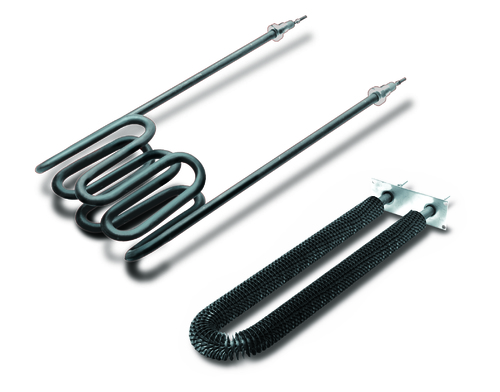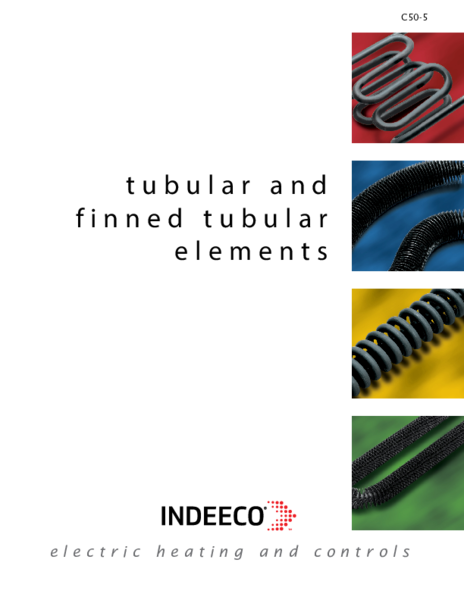Tubular & Finned Tubular Elements
Our product offering ranges from standard tubular heating elements to the most sophisticated, custom designed systems. Indeeco’s attention to detail and rigorous testing give worldwide customers premium products that they receive quickly and at a fair price.
Good design makes a difference. So do high standards for construction. Indeeco excels at both, and those strengths combine to yield outstanding results in the quality of our tubular heating elements and finned tubular elements.
Standard Features
Tubular elements have a coil of high grade-resistance wire centered in a heavy gauge metal tube filled with magnesium oxide powder. It is rolled to reduce its diameter and compact the powder, insuring rapid heat transfer from the coil to the sheath and high dielectric strength.
For finned tubular elements, designed and built for the requirements of each job, we have standardized on stainless steel because of its superior resistance to moisture and corrosion.
Applications
There are many applications where tubular construction is appropriate, such as these:
Clamped
Elements clamped onto a surface establish essentially line contact. This method should be used only at relatively low temperatures.
Inserted
Elements may be slipped into drilled holes in metal platens or dies, or sandwiched between semi-cylindrical grooves in two matching dies or platens.
Cast In
Elements may be cast into a variety of metals for applications requiring uniform heat distribution.
Immersion
Elements for these applications are furnished with threaded fittings or bent in such a way that the terminals protrude over the side of the vessel.
Radiant
Stainless steel or Incoloy sheathed elements may heat processes by radiation. Element temperature will vary with the work temperature, distance between the work and the element, and atmospheric conditions.
Air Heating
Either finned or unfinned elements can be used in both forced and natural convection applications.
Construction
One-Pass Construction
The cutaway view of a typical Indeeco tubular element shows its basic construction. A coil of high grade-resistance wire (nickel, chromium) is precisely centered in a heavy gauge metal tube while the tube is filled with granular magnesium oxide powder. Cold pins are welded to the resistance coil at each end to provide an unheated length near the terminals and to secure the coil in the magnesium oxide. Through rolling, the diameter of this assembly is reduced and the magnesium oxide compacted, insuring rapid heat transfer from the coil to the sheath, as well as high dielectric strength.
After compaction, the element is processed in one of three ways:
- Straight length elements are sealed and appropriate terminals applied.
- Formed elements are annealed and bent before they are sealed and terminated.
- Finned elements are wound with a helical fin before processing as described in #1 and #2 above.
Two-Pass Construction
For applications requiring both terminations at the same end, two-pass construction may be used. Two-pass elements, as shown in the cutaway view, have a U-bent coil inside the sheath and two leads or terminals at one end. The opposite end is sealed by welding or silver soldering. These elements are available in straight lengths, either finned or unfinned. They can be permanently mounted with a variety of factory-furnished mounting methods (see “Mounting Accessories”). By contrast, one-pass elements in straight lengths must have a flexible electrical connection at one end to allow for thermal expansion.
Finned Construction
A corrugated metal fin is helically wound on a tubular element to improve heat transfer in air applications. Depending on the sheath and fin material selected, the fins are either permanently attached, mechanically or via furnace brazing. The entire assembly then goes through a computer controlled atmosphere furnace. This process prepares the element to be bent into a variety of configurations. Standard fin density is five fins per inch, while eight fins per inch can be furnished when specified for lower sheath temperatures.
Construction Techniques
Indeeco construction techniques are designed to insure high quality and long life.
- Rolling – All standard diameter elements listed in this catalog are compacted through multi-stage rolls. This process insures uniform compaction of the magnesium oxide, a truly round cross section and a consistent diameter. This is critical if the element is being inserted into a machined hole.
- Terminal Construction – A threaded stainless steel terminal is welded onto the cold pin for the standard construction. Stainless steel nuts and washers are furnished for field wiring. The terminal must be prevented from rotating when connecting field wiring.
- Terminal Insulator and Seals — Element ends are normally sealed against moisture, which can rapidly deteriorate the insulating properties of magnesium oxide. The terminal insulator and seal must be suitable for the temperature, voltage and atmospheric conditions of the application. Indeeco offers a wide variety of terminals, insulators and seals to meet virtually any combination of field conditions (see “Terminals, Insulators & Seals”).
- Recompaction – In the process of bending, density is reduced in the compacted magnesium oxide. These reductions, in turn, can lead to overheating and coil failure, especially at high temperatures or high watt densities. To prevent such failures, we recompress bends to improve density in the magnesium oxide when necessary.

